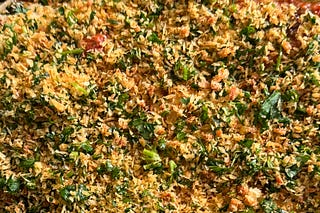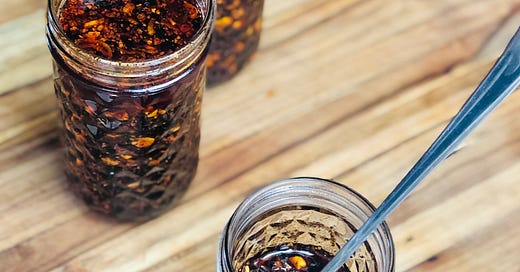

Discover more from Hot Dish with Sohla
Pasta al Limone Walked So This Baby Could FLY
sumac & lemon pasta recipe, plus glossy pasta tips
Okay, I admit it. Last week's recipe was a lot. I asked you to perform minor chicken butchery, wait two whole days, and buy prunes. This week, we’re gonna keep things chill with a recipe that requires 20 minutes and six ingredients (including salt!). I first made this sumac and lemon pasta because I thought pasta would be pretty all speckled with pink, but she turned out to be so much more than cute.
Sumac brings fruity and funky depth to the classic Pasta al Limone. Something magical happens from layering different sources of acid—lemon juice brings citric acid to the party, while sumac steps in with malic acid, causing your tongue to curl in all kinds of ways. It’s what makes this seemingly simple dish taste so complex. I can’t really explain it. It’s tart, tannic, juicy, and just really freaking good.
I think everyone knows Pasta al Limone by now, if only thanks to Emily Mariko's viral version. It’s a classic Italian dish where pasta is finished with butter, lemon, and cheese. Folks got all riled up because she put the lemon halves in there. To be fair, she was trying to recreate the Limone they serve at Frank restaurant in New York, where they do add lemon halves to perfume the dish. Where she really went wrong was that her sauce wasn’t emulsified.
In the food world, emulsification means that you’re getting fat and water, two things that don’t want to hook up, to connect in creamy glory. The most obvious emulsion is a vinaigrette. Just stir oil and vinegar together, and you’ll end up with a thin dressing that leaves puddles all over your greens. But give that same mixture a hearty shake in a jar, and it becomes thick, unctuous, and lusciously coats each leaf. It’s the magic behind mayonnaise, cake batter, pan sauces, and nearly every pasta dish from Cacio e Pepe to Carbonara.
Here are five tips for epically emulsified pasta every time
1. Step away from the Microplane grater!
(Okay, after you’ve zested your lemon.) The Microplane grater is fantastic for quickly turning garlic or ginger into a pulp and getting feathery-light shaves of citrus zest, but it’s bad news for cheese. Cheese grated on a Microplane is so fine that it melts too fast, making your pasta sauce clump, get greasy, and stick to the skillet.
There are two better ways to break down your cheese:
Use the small holes on a box grater. This is best if you don’t make pasta that often, so you can grate just what you need, keeping the flavor and aroma of the cheese at its peak.
Use a knife to break down the cheese into 1 to 2-inch chunks. Then, pulse the pieces in a food processor or high-speed blender until ground down to the size of coarse bread crumbs. This is a great way to break down a lot of cheese, which is useful if you're making pasta often. After a week, the grated cheese will begin to lose flavor, so don’t process more than what you'll use up in that time.
2. You need more water than you think
It might seem counterintuitive that more water will make a sauce creamier, but emulsification needs two to tango. The fat you add to pasta needs water to disperse into. Not enough water and the emulsion will break, making the sauce greasy. Also, pasta is always soaking up water—as you stir, as you serve, and as you eat. Make your sauce looser than you want it to be when you sit down cause that pasta never stops drinking.
3. Temperature matters
Once you drain your pasta, you need to move quickly. Just out of the boiling water, the pasta and pasta water is at the perfect temperature to create an emulsion. Have all your sauce ingredients ready before it’s time to drain, so the pasta doesn’t have a chance to cool down. Don't let the sauce get too hot when you start stirring everything together on the stovetop. You want just enough heat to keep everything steamy, but if the sauce simmers, it will break.
4. Stir like you've never stirred before
Remember when you shake oil and vinegar, it gets creamy? Same deal here with pasta sauce. There is some starch in pasta water that helps bring things together, but the real work is done by vigorous stirring. In restaurants, cooks get real wild, aggressively flipping and tossing pasta in a skillet. You don’t need to have that much coordination, but don’t be shy and get everything grooving, even if some noodles go overboard.
5. Trust the process
When you first combine the drained pasta with fat, cheese, and pasta water, it’s gonna look watery, clumpy, and greasy. Don’t give up! It will become gorgeously glossy if you keep vigorously stirring over gentle heat. I just imagine Dory singing in my head, “just keep stirring, just keep stirring, stirring.”
Sumac & Lemon Pasta
serves 1 to 3 | active time: 20 minutes | total time: 20 minutes
PRINTABLE RECIPE HERE:
INGREDIENTS
kosher salt
8 ounces spaghetti (½ box)
1 medium lemon
3 tablespoons unsalted butter
2 ounces coarsely grated parmesan cheese (scant 1 cup)
1 tablespoon sumac, plus more to serve
Bring a high-sided skillet or medium pot of water to a boil and season generously with kosher salt (see note).
Add pasta and cook, stirring occasionally, until it’s slightly more firm than you want your final spaghetti to be. (I like my pasta with a lot of texture, so I cook it until the spaghetti just gets floppy but is still raw in the center.)
Meanwhile, get set up for saucing: Finely grate the zest of the lemon. Cut the lemon in half and squeeze all the juice into a small bowl. Cut the butter into ½-inch cubes. Have the grated cheese, sumac, serving plates, and any side dishes ready to go. Tell the folks you’re feeding to be on standby—this pasta must be eaten hot off the stove.
Once the pasta is cooked, reserve 1 cup of pasta water, then drain.
Return the drained pasta to the pan. Add the lemon zest and juice, butter, cheese, sumac, and ½ cup reserved pasta water. Turn the heat to medium-low and vigorously stir everything together with a stiff spatula or wooden spoon. Add more pasta water, a splash at a time, and keep rapidly stirring until the butter and cheese melts and the sauce becomes thick and creamy, about 3 minutes. (I usually end up needing the full cup of pasta water.) Once the sauce is exactly the thickness you want, add another splash of water to ensure that it’s still that saucy when it gets to the table.
Serve right away with more sumac sprinkled on top.
Notes
SALTING PASTA WATER: The more water you cook your pasta in, the more salty the water needs to be, because most of that salt will end up down the drain. When cooking pasta in just enough water to cover, I season the water until it tastes like a too-salty soup. But if I’m boiling pasta in a big pasta pot, I will season it until it’s as salty as an olive brine.
DOUBLE THE RECIPE: Want to make a whole box? Double all the amounts and cook the pasta in a large pot or medium dutch oven. This gives you lots of room to groove when it’s time to stir vigorously and get saucy. (You will need to reserve a full 2 cups or more of pasta water!)
Ingredient/Equipment Substitutions
GLUTEN-FREE PASTA: The pasta water from gluten-free pasta isn’t always starchy enough to create a creamy sauce, so I like to add some extra starch to help it along.
For every 8 ounces gluten-free pasta: In a small bowl or jar with a lid, combine 1 teaspoon cornstarch or tapioca starch with 2 tablespoons cold water. Whisk or shake it up until no lumps remain. Add this mixture to the pasta during the saucing step (step 5) along with the reserved pasta water and other ingredients.
PARMESAN CHEESE: Swap in an equal amount of any hard cheese, like Pecorino or Grana Padano.
Let me know if you try this!
xx Sohla
















the speed at which i smashed subscribe to see this pasta is alarming
Finally! Someone who is willing to acknowledge that half a box of pasta can be one serving ;)